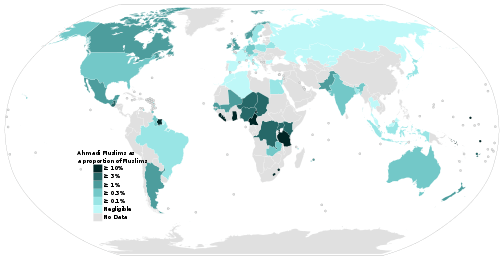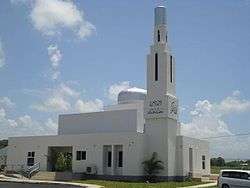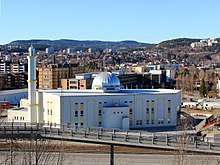Ahmadiyya by country
Ahmadiyya is an Islamic religious movement originating in 1889 in northern India around the teachings of Mirza Ghulam Ahmad (1835–1908), who claimed to have been divinely appointed as both the promised Mahdi and Messiah expected by Muslims to appear towards the end times.
| Ahmadiyya by country |
|---|
 |
|
Africa
|
|
Asia
|
|
Europe
|
|
Americas
|
|
Oceania
|
As of 2016 the Community has been established in 209 countries and territories of the world.[1][2][3][n 1] with concentrations in South Asia, West Africa, East Africa and Indonesia. The Community is a minority Muslim group in almost every country of the world. On the other hand, it has spread to most countries of the world.[4][5] In some countries, it is practically illegal to be an Ahmadi Muslim. For instance, in Pakistan, following Ordinance XX, Ahmadis cannot call themselves Muslims, profess the Islamic creed publicly or call their places of worship mosques. Together, these factors make it difficult to estimate the Ahmadiyya population for both the Community itself and as well as independent organizations. For this reason, the Community gives a figure of "tens of millions";[6] however, most independent sources variously estimate the population to be at least 10 to 20 million[7] worldwide, thereby representing around 1% of the world's Muslim population.[n 2]
According to the World Christian Encyclopedia, the Ahmadiyya movement is the fastest growing Islamic group as of the early 21st century.[n 3] The country with the largest Ahmadiyya population is Pakistan, with an estimated 4 million Ahmadi Muslims.[8] Excluding small nations, the country with the largest proportion of Ahmadi Muslims to the wider Muslim population is Ghana, standing at 16%. The country with the highest percentage of the overall population is Sierra Leone standing at over 8%.
The population is almost entirely contained in the single, organized and united movement, commonly referred to as the Ahmadiyya Muslim Community (AMC), headed by the Khalifa. The other is the Lahore Ahmadiyya Movement, a separatist group which, though historically significant, has failed to attract a sizeable following representing less than 0.2% of the total Ahmadiyya population.[n 4]
Countries
Maps
The following maps summarize the data presented in the table below.


Table
The following figures display estimates of the number of Ahmadi Muslims and their percentages by country. However, it does not list all the countries with the Ahmadiyya presence. In particular, it does not list a number of countries which have a large presence of Ahmadis. This includes Benin, Burkina Faso, Ivory Coast, Guinea, The Gambia and a number of Arab States.





| Country/Region | Ahmadiyya population | Percentage (%) of Muslims | Percentage (%) of population |
Notes/ Sources |
|---|---|---|---|---|
| 2,000 | < 0.1 | < 0.1 | Estimate[9][10] | |
| 15,500 | 2.0 | < 0.1 | Estimate[11] | |
| 3,000 | 0.8 | < 0.1 | Estimate[12] | |
| 300 | 0.1 | < 0.1 | Estimate[13] | |
| 100,000 | 0.1 | 0.1 | Estimate[14][n 5] | |
| 30 | 0.2 | < 0.1 | Estimate[15] | |
| 1,250 | 0.2 | < 0.1 | Estimate[16] | |
| 50 | 1.8 | < 0.1 | Estimate[17] | |
| 20 | 0.1 | < 0.1 | Estimate[18] | |
| 400 | < 0.1 | < 0.1 | Estimate[19] | |
| 430,000 | 12.0 | 2.2 | PRC[20] | |
| 25,000 | 2.5 | 0.1 | Estimate[21] | |
| 220,000 | 4.0 | 2.0 | PRC[20] | |
| 540,000 | 6.0 | 0.7 | PRC[20] | |
| 600 | 0.3 | < 0.1 | Estimate[22] | |
| 50,000 | 0.1 | < 0.1 | Estimate[23] | |
| 2,000 | 3.6 | 0.3 | 1996 Census[n 6] | |
| 1,000 | < 0.1 | < 0.1 | Estimate[24] | |
| 45,000 | 0.9 | < 0.1 | Estimate[25][26][27] | |
| 635,000 | 16.0 | 2.5 | PRC[20][n 7] | |
| 1,000 | 10 | < 0.1 | Estimate[28] | |
| 13,000 | 2.0 | 0.8 | PRC[20] | |
| 200* | 0.4 | < 0.1 | Estimate[n 8] | |
| 1,000,000 | 0.6 | < 0.1 | Estimate[29][30] | |
| 400,000 | 0.2 | 0.2 | ARDA[31][32] | |
| 500 | 1.2 | < 0.1 | Estimate[33] | |
| 2,200 | 0.2 | < 0.1 | Estimate[34] | |
| 500 | < 0.1 | < 0.1 | Estimate[35] | |
| 100 | 2.0 | < 0.1 | Estimate[36] | |
| 300 | 0.3 | < 0.1 | Estimate[37] | |
| 500 | < 0.1 | < 0.1 | Estimate[38] | |
| 198,000 | 4.0 | 0.3 | PRC[20] | |
| 1,000 | < 0.1 | < 0.1 | Estimate[39] | |
| 350 | 35.0 | < 0.1 | AMC[40]:76 | |
| 85,000 | 10.0 | 1.2 | PRC[20] | |
| 2,000 | < 0.1 | < 0.1 | Estimate[41] | |
| 260,000 | 2.0 | 1.6 | PRC[20] | |
| 10 | 100.0 | < 0.1 | Estimate[42] | |
| 4,000 | 1.9 | 0.3 | Estimate[43] | |
| 100 | 2.7 | < 0.1 | Esitimate[44] | |
| 500 | < 0.1 | < 0.1 | Esitimate[45] | |
| 1,500 | 0.2 | < 0.1 | Estimate[46] | |
| 400 | 1.0 | < 0.1 | Estimate[47] | |
| 970,000 | 6.0 | 5.5 | PRC[20] | |
| 2,840,000 | 3.0 | 1.3 | PRC[20] | |
| 1,600 | 1.0 | < 0.1 | Estimate[48] | |
| 600,000 – 4,900,000 | 0.3 – 2.2 | 0.3 – 2.2 | Various estimates[n 9] | |
| 38 | 0.2 | < 0.1 | Estimate[49] | |
| 50 | < 0.1 | < 0.1 | Estimate[38] | |
| 116,000 | 1.0 | 0.9 | PRC[20] | |
| 500,000 | 12.0 | 8.1 | AMC | |
| 200 | < 0.1 | < 0.1 | 1970s Estimate[50] | |
| 1,000 | 50.0 | 0.2 | Estimate[n 10] | |
| 500 | < 0.1 | < 0.1 | Estimate[51] | |
| 14,000 | 18.9 | 2.6 | 2012 Census[n 11] | |
| 250 | 12.5 | < 0.1 | AMC[40]:107 | |
| 800 | 0.2 | < 0.1 | Estimate.[n 12] | |
| 800 | 0.2 | < 0.1 | Estimate[52] | |
| 2,540,000 | 15.0 | 4.5 | PRC[20] | |
| 300 | < 0.1 | < 0.1 | AMC Estimate[53] | |
| 500* | 0.7 | < 0.1 | Estimate[n 13] | |
| 50 | 100.0 | 0.5 | 2005 Estimate[54] | |
| 192,000 | 4.0 | 0.5 | PRC[20] | |
| 30,000 | 1.0 | < 0.1 | Estimate[55] | |
| 15,000 | 0.6 | < 0.1 | Estimate[56] | |
| 500 | 0.8 | < 0.1 | Estimate[57] | |
See also
Islam:
Other religions:
References
Notes
- Depending on the definition, there are 195 or 196 countries in the world, of which 193 are member states of the United Nations. Under the constitutive theory of statehood there are 206 sovereign states. There are dozens of territories and colonies that are sometimes erroneously called "countries". See:
- "The Number of Countries in the World". Retrieved February 15, 2015.
- A figure of 10 to 20 million represents 0.62% to 1.25% of the world's Muslim population.
- The Ahmadiyya Movement has been the fastest growing Islamic group according to the World Christian Encyclopedia for a number of decades. For this, see earlier editions. The 2001 edition places the growth rate at 3.25%, which is the highest of all Islamic sects and schools of thought. See:
- David B. Barrett; George Thomas Kurian; Todd M. Johnson, eds. (February 15, 2001). World Christian Encyclopedia. Oxford University Press USA. ISBN 0195079639.
- The Lahore Ahmadiyya Movement has unofficially stated its total population to be up to 30,000, of which 5,000 to 10,000 live in Pakistan. On this basis, the Lahore Ahmadiyya Movement represents approximately 0.2% of the total Ahmadiyya population.See:
- Simon Ross Valentine (2008-10-06). Islam and the Ahmadiyya Jamaʻat: History, Belief, Practice. Columbia University Press. p. 61. ISBN 978-0-231-70094-8.
- "Pakistan: Situation of members of the Lahori Ahmadiyya Movement in Pakistan". Retrieved April 30, 2014.
- There is also an upper estimate of 200,000 Ahmadi Muslims in Bangladesh.
- The actual figure as stated in the 1996 census is 1,976.
- Ghana's Muslims have previously raised concern over the census figures which states that 17% of Ghanaians belong to the Muslim faith. It is claimed that Muslims represent somewhere between 30 and 45% of Ghana. Under this, the Ahmadiyya population would number almost 2 million. The Ahmadiyya Muslim Community itself gives an estimate of over 2 million Ahmadis in Ghana. See:
- "Muslims cry foul over population figures". News From Africa. Archived from the original on May 2, 2014. Retrieved April 30, 2014.
- Ahmadiyya Muslim Mosques Around the World – A Pictorical Presentation. Ahmadiyya Muslim Community; Khilafat Centenary Edition. 2008. p. 70. ISBN 978-1882494514.
- There are over 200 members of the Ahmadiyya Muslim Community in Guyana. However, the Lahore Ahmadiyya movement is also active in Guyana, for which figures are unavailable at the moment. Thus, a figure of 200 is unlikely to be representative of the total Ahmadiyya population. See:
- The 1998 Pakistani census states that there are 291,000 (0.22%) Ahmadis in Pakistan. However, the Ahmadiyya Muslim Community has boycotted the census since 1974 which renders official Pakistani figures to be inaccurate. Independent groups have estimated the Pakistani Ahmadiyya population to be somewhere between 2 million and 5 million Ahmadis. However, the 4 million figure is the most quoted figure. See:
- 600,000: Freedom House. "The Impact of Blasphemy Laws on Human Rights". p. 120. Missing or empty
|url=(help) - over 2 million: Immigration and Refugee Board of Canada (2008-12-04). "Pakistan: The situation of Ahmadis, including legal status and political, education and employment rights; societal attitudes toward Ahmadis (2006 – Nov. 2008)". Retrieved 2012-06-28.
- 3 million: International Federation for Human Rights: International Fact-Finding Mission. Freedoms of Expression, of Association and of Assembly in Pakistan. Ausgabe 408/2, Januar 2005, S. 61 (PDF)
- 3–4 million: Commission on International Religious Freedom: Annual Report of the United States Commission on International Religious Freedom. 2005, S. 130
- 4.910.000: James Minahan: Encyclopedia of the stateless nations. Ethnic and national groups around the world. Greenwood Press . Westport 2002, page 52
- "Pakistan: Situation of members of the Lahori Ahmadiyya Movement in Pakistan". Retrieved April 30, 2014.
- 600,000: Freedom House. "The Impact of Blasphemy Laws on Human Rights". p. 120. Missing or empty
- It is estimated that there are 1,000 Ahmadis in the country. However, Sunni Muslims claim to have more followers in the country. Taking a lower bound, it can be stipulated that Ahmadis represent 50% of the country's Muslims. See
- "Muslims in Melanesia: putting security issues in perspective". Australian Journal of International Affairs. Taylor & Francis. 62 (3): 408–429. September 2008.
- The exact figure as stated in the 2012 census is 14,161
- Estimates range from 500 to 1,100. See:
- Lewis, James R. (2015). Handbook of Nordic New Religions. Brill. p. 362.
- There are over 500 members of the Ahmadiyya Muslim Community. However, there is also a large presence of the Lahore Ahmadiyya movement, for which figures are unavailable. Thus, a figure of 500 is unlikely to be representative of the total Ahmadiyya population. See:
- The Encyclopedia of Caribbean Religions: Volume 1: A-L; Volume 2: M-Z. p. 33–38 https://books.google.com/books?id=XOyYCgAAQBAJ&printsec=frontcover#v=onepage&q&f=false. Missing or empty
|title=(help)
- The Encyclopedia of Caribbean Religions: Volume 1: A-L; Volume 2: M-Z. p. 33–38 https://books.google.com/books?id=XOyYCgAAQBAJ&printsec=frontcover#v=onepage&q&f=false. Missing or empty
Citations
- "More than 584,000 people join Ahmadiyya Muslim Community as annual convention held". swlondener.co.uk. August 15, 2016. Retrieved August 24, 2016.
- "More than 584,000 people join the Ahmadiyya Muslim Community". Ahmadiyya Muslim Community Press and Media Office. August 18, 2016. Archived from the original on September 11, 2016. Retrieved August 24, 2016.
- "Argyll's Magnus MacFarlane-Barrow to receive Muslim peace prize". Retrieved February 15, 2015.
- Baumann, Martin; Melton, J. Gordon (2010). Religions of the World: A Comprehensive Encyclopedia of Beliefs and Practices, 2nd Edition [6 volumes]: A Comprehensive Encyclopedia of Beliefs and Practices. ABC-CLIO. p. 58. ISBN 9781598842043.
- Duff, Michael (2008-07-31). Salam + 50. World Scientific. ISBN 9781908978899.
- "An Overview". Al Islam. Retrieved March 4, 2014.
- See:
- Breach of Faith. Human Rights Watch. June 2005. p. 8. Retrieved March 29, 2014.
Estimates of around 20 million would be appropriate
- Larry DeVries; Don Baker; Dan Overmyer (2011-01-01). Asian Religions in British Columbia. University of Columbia Press. ISBN 978-0-7748-1662-5. Retrieved March 29, 2014.
The community currently numbers around 15 million spread around the world
- Juan Eduardo Campo (2009). Encyclopedia of Islam. p. 24. ISBN 0-8160-5454-1. Retrieved March 29, 2014.
The total size of the Ahmadiyya community in 2001 was estimated to be more than 10 million
- "Ahmadiyya Muslims". pbs.org. Retrieved 6 October 2013.
- Breach of Faith. Human Rights Watch. June 2005. p. 8. Retrieved March 29, 2014.
- The 1998 Pakistani census states that there are 291,000 (0.22%) Ahmadis in Pakistan. However, the Ahmadiyya Muslim Community has boycotted the census since 1974 which renders official Pakistani figures to be inaccurate. Independent groups have estimated the Pakistani Ahmadiyya population to be somewhere between 2 million and 5 million Ahmadis with the 4 million figure being the most quoted figure and accounting for approximately 2.2% of the country. See:
- over 2 million: Immigration and Refugee Board of Canada (2008-12-04). "Pakistan: The situation of Ahmadis, including legal status and political, education and employment rights; societal attitudes toward Ahmadis (2006 - Nov. 2008)". Retrieved 2012-06-28.
- 3 million: International Federation for Human Rights: International Fact-Finding Mission. Freedoms of Expression, of Association and of Assembly in Pakistan. Ausgabe 408/2, Januar 2005, S. 61 (PDF)
- 3–4 million: Commission on International Religious Freedom: Annual Report of the United States Commission on International Religious Freedom. 2005, S. 130
- 4.910.000: James Minahan: Encyclopedia of the stateless nations. Ethnic and national groups around the world. Greenwood Press . Westport 2002, page 52
- "Pakistan: Situation of members of the Lahori Ahmadiyya Movement in Pakistan". Retrieved April 30, 2014.
- "Algeria: Wave of arrests and prosecutions of hundreds of Ahmadis". Amnesty International. 19 June 2017. Retrieved 12 October 2017.
- "Algeria finds sect leader guilty of 'offending Islam'". The Jordan Times. 13 September 2017. Retrieved 12 October 2017.
- "El Islam en Argentina". September 15, 2015. Retrieved February 15, 2015.
- "A good Muslim's better life cut short by extremists". Sydney Morning Herald. March 11, 2012. Retrieved February 22, 2014.
- Jørgen Nielsen; Samim Akgönül; Ahmet Alibašić; Egdunas Raciu (2013-09-19). Yearbook of Muslims in Europe, Volume 5. p. 55. ISBN 9789004255869. Retrieved February 25, 2014.
- "Bangladesh bans Islam sect books". BBC News. January 9, 2004. Retrieved February 22, 2014.
- "Ahmadiyya Muslims among Banned Religious Organisations". UNHCR. November 4, 2003. Retrieved May 2, 2014.
- Khalid Saifullah. "Social and Economic Influence of Ahmadiyya Muslim Community in Flanders-Belgium" (PDF). Retrieved April 30, 2014.
- "Spreading The Message Of Islam in Belize". Retrieved February 14, 2015.
- "Comunidade Ahmadia No Brasil".
- "Bulgaria: Ahmadis barred "because it is against the religions that people follow here"". Retrieved May 31, 2014.
- "The World's Muslims: Unity and Diversity" (PDF). Pew Forum on Religious & Public life. August 9, 2012. Archived from the original (PDF) on 2012-10-24. Retrieved February 22, 2014.
- Don Baker; Daniel L. Overmyer; Larry DeVries (August 9, 2012). Asian Religions in British Columbia. UCB Press. p. 73. ISBN 9780774859424. Retrieved February 22, 2014.
- Mikkel Rytter (2013-06-30). Family Upheaval: Generation, Mobility and Relatedness among Pakistani. Berghahn Books. p. 14. ISBN 9780857459404. Retrieved February 23, 2014.
- Mohammad Hassan Khalil (2013-01-31). Between Heaven and Hell: Islam, Salvation, and the Fate of Others. Oxford University Press. p. 297. ISBN 9780199945412. Retrieved March 1, 2014.
- Jørgen Nielsen; Samim Akgönül; Ahmet Alibašić; Egdunas Racius (2014-10-31). Yearbook of Muslims in Europe. 6. p. 229. ISBN 9789004283053.
- "Mitgliederzahlen: Islam", in: Religionswissenschaftlicher Medien- und Informationsdienst|Religionswissenschaftliche Medien- und Informationsdienst e. V. (Abbreviation: REMID), Retrieved 3 January 2016
- "Anzahl der Muslime in Deutschland nach Glaubensrichtung im Jahr 2015* (in 1.000)", in: Statista GmbH, Retrieved 3 January 2016
- "Mosque construction continues with community support: Ahmadi Muslim leader, Retrieved 22 July 2016
- "Ahmadía, el ala pacífi ca del Islam, atrae a guatemaltecos". Retrieved June 2, 2014.
- "Wretched Of The Land".
- Susan Snow Wadley (2013-12-27). South Asia in the World: An Introduction. M.E. Sharpe Inc. p. 88. ISBN 9780765639684.
- "Indonesia". The Association of Religious Data. Retrieved April 26, 2014.
- Bruce Vaughn (November 2010). Indonesia: Domestic Politics, Strategic Dynamics, and American Interests. Diane Publishing Co. p. 20. ISBN 9781437927559. Retrieved February 22, 2014.
- Lorna Siggins (September 20, 2014). "Persecuted Muslims build first Irish mosque in Galway". Irish Times. Retrieved September 20, 2014.
- Estimate:
- Kababir only (2,200):"Kababir". Israel and You. Archived from the original on 30 January 2015. Retrieved 26 January 2015.
- 1990s Estimate (1,000):Ori Stendel (1996). The Arabs in Israel. Sussex Academic Press. p. 45. ISBN 1898723249. Retrieved March 4, 2014.
- "Gli Ahmadi". Retrieved February 14, 2015.
- "Old Harbour Muslim community fighting crime through youth programmes and sports". April 22, 2015. Archived from the original on March 5, 2017. Retrieved October 28, 2016.
- Numajiri, Masayuki (March 29, 2010). "World Religion Crossing The Border : The Future of Gods in the Era of Globalization" (PDF). Otemon Gakuin University Sociology Bulletin (in Japanese). Otemon Gakuin University: 64.
- Anna Tsurkan. "Альтернативный ислам на постсоветском пространстве: особенности распространения ахмадиййата" (in Russian). Keston Institute. Archived from the original on November 19, 2017. Retrieved October 1, 2016.
- "Kyrgyz Officials Reject Muslim Sect". RFE/RL. January 6, 2012. Archived from the original on January 6, 2012. Retrieved February 24, 2014.
- Ahmadiyya Muslim Mosques Around The World – A Pictorical Presentation. Ahmadiyya Muslim Community; Khilafat Centenary Edition. 2008. ISBN 978-1882494514.
- "Malaysia's Ahmadis living dangerously". November 8, 2011. Archived from the original on May 2, 2014. Retrieved April 30, 2014.
- International Religious Freedom Report 2009: Marshall Islands. United States Bureau of Democracy, Human Rights and Labor (September 14, 2007).
- Hollup, Oddvar (1996). "Islamic Revivalism and Political Opposition among Minority Muslims in Mauritius". Ethnology. 35 (4).
- "Islam Comes to Merida". Yucatan Living. Archived from the original on February 14, 2015. Retrieved February 14, 2015.
- "القادياناية تغزو المغرب ووزارة الأوقاف تدق ناقوس الخطر" (in Arabic). November 18, 2013. Archived from the original on November 21, 2013. Retrieved October 26, 2016.
- "Poort krijgt nieuwe moskee". December 13, 2013. Archived from the original on 2014-04-26. Retrieved April 26, 2014.
- "Prayers for Opening". stuff.co.nz. October 31, 2013. Retrieved March 4, 2014.
- Regjeringen.no (2019-12-02). "Tilskuddstellende medlemmer - 2019" (PDF). Regjeringen.no. Retrieved 2019-12-16.
- Sobczyński, Marek; Of Political Geography And Regional Studies, Uniwersytet Łódzki. Dept; Opolu, Państwowy Instytut Naukowy-Instytut Śląski W; (Poland), Silesian Institute Society (2005). The role of borderlands in united Europe: historical, ethnic and geopolitical problems of borderlands. p. 142. ISBN 9788371261992.
- James L. Peacock (1978). Muslim Puritans: Reformist Psychology in Southeast Asian Islam. University of California Press. p. 147. ISBN 9780520034037. Retrieved February 25, 2014.
- Gerardo Elorriaga (June 24, 2014). "El Islam del amor" (in Spanish). Retrieved August 4, 2015.
- Matthias Kortmann; Kerstin Rosenow-Williams. Islamic Organizations in Europe and the USA: A Multidisciplinary Perspective. p. 102. Retrieved February 23, 2014.
- "Monthly Sinar Islam". Vol. 2 (5 ed.). May 2015. Cite magazine requires
|magazine=(help) - Gary D. Bouma; Rodney Ling; Douglas Pratt (2010). Religious Diversity in Southeast Asia and the Pacific. p. 198.
- "Ahmadiyya Muslim Community celebrates 100 years since first missionary came to UK". This is Local London. June 3, 2013. Retrieved May 2, 2014.
- "Muslim group to get own caucus on Capitol Hill". Washington Times. February 27, 2014. Retrieved March 1, 2014.
- Some basics of religious education in Zambia. Retrieved March 30, 2014.
